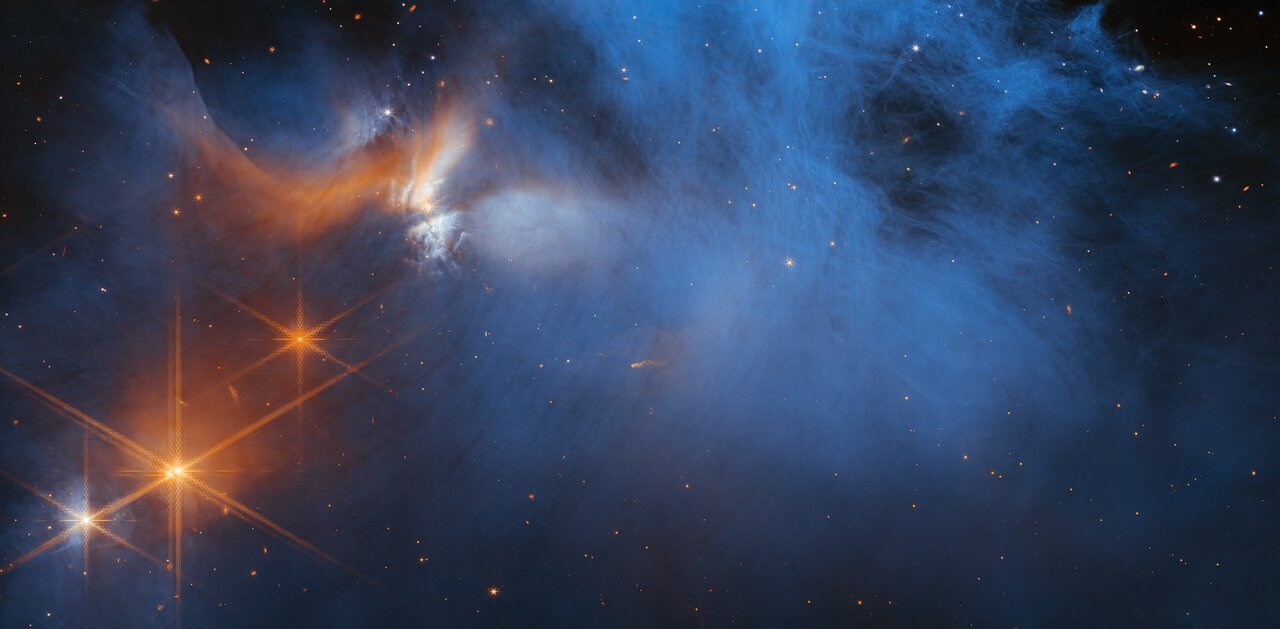NASA GSFC | STScI Webb | ESA Webb | ESA Space Science | 2023 Jan 23
The discovery of diverse ices in the darkest, coldest regions of a molecular cloud measured to date has been announced by an international team of astronomers using the NASA/ESA/CSA James Webb Space Telescope. This result allows astronomers to examine the simple icy molecules that will be incorporated into future exoplanets, while opening a new window on the origin of more complex molecules that are the first step in the creation of the building blocks of life.Webb’s View of the Molecular Cloud Chameleon I
- A large, dark cloud is contained within the frame. In its top half it is textured like smoke and has wispy gaps, while at the bottom and at the sides it fades gradually out of view. On the left are several orange stars: three each with six large spikes, and one behind the cloud which colours it pale blue and orange. Many tiny stars are visible, and the background is black.
Image Credit: NASA, ESA, CSA, and M. Zamani (ESA/Webb);
Science Credit: Fengwu Sun (Steward Observatory),
Zak Smith (The Open University), IceAge ERS Team
If you want to build a habitable planet, ices are a vital ingredient as they are the main carriers of several key light elements — namely carbon, hydrogen, oxygen, nitrogen, and sulphur (referred to collectively as CHONS). These elements are important ingredients in both planetary atmospheres and molecules like sugars, alcohols, and simple amino acids. In our Solar System, it is thought they were delivered to Earth’s surface by impacts with icy comets or asteroids. Furthermore, astronomers believe such ices were most likely already present in the dark cloud of cold dust and gas that would eventually collapse to make the Solar System. In these regions of space, icy dust grains provide a unique setting for atoms and molecules to meet, which can trigger chemical reactions that form very common substances like water. Detailed laboratory studies have further shown that some simple prebiotic molecules can form under these icy conditions.
Now an in-depth inventory of the deepest, coldest ices measured to date in a molecular cloud] has been announced by an international team of astronomers using the NASA/ESA/CSA James Webb Space Telescope. In addition to simple ices like water, the team was able to identify frozen forms of a wide range of molecules, from carbonyl sulfide, ammonia, and methane, to the simplest complex organic molecule, methanol (in the interstellar medium, organic molecules are considered to be complex when having six or more atoms). This is the most comprehensive census to date of the icy ingredients available to make future generations of stars and planets, before they are heated during the formation of young stars. These icy grains grow in size as they are funnelled into the protoplanetary discs of gas and dust around these young stars, essentially allowing astronomers to study all the potential icy molecules that will be incorporated into future exoplanets. ...
An Ice Age JWST Inventory of Dense Molecular Cloud Ices ~ M. K. McClure et al
- Nature Astronomy (online 23 Jan 2023) DOI: 10.1038/s41550-022-01875-w
- arXiv > astro-ph > arXiv:2301.09140 > 22 Jan 2023
